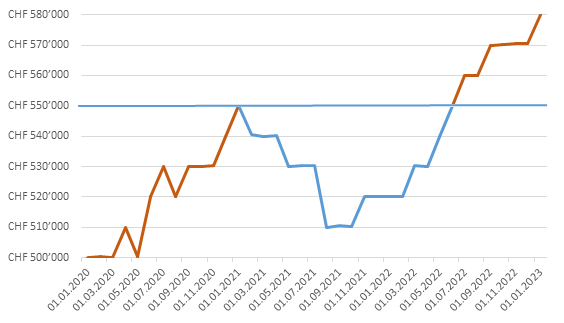High Watermark
Would you like to invest your money? Get in touch with an expert:
What is the High Watermark?
Fees charged by asset managers are calculated in a variety of ways. There is a variant of the fee calculation known as the High Watermark. The High Watermark method can be used to calculate performance-based asset management fees. Generally, the highest value reached by a securities portfolio or investment fund is referred to as the High Watermark and serves as a reference point. In order to determine the High Watermark, the cumulative historical returns are used. This variable is used to evaluate the performance of the asset manager in the following year. If the asset manager's performance is inadequate, the High Watermark prevents him or her from earning large sums of money. The asset manager, for example, must bring the portfolio or fund above the High Watermark before receiving a performance bonus on assets under management (AUM). The investor pays this bonus as a performance fee.
There is a difference between a High Watermark and a Hurdle Rate. The Hurdle Rate is defined as the minimum profit that a hedge fund needs to achieve in order to be eligible for an incentive fee. Combining the High Watermark method and the Hurdle Rate method is also possible.
Calculation of the High Watermark - Example
Consider the case of an investor who opens a custody account with CHF 500,000. The asset manager increased the assets to CHF 550,000 in 2020. Therefore, CHF 550,000 (highest level) represents the new High Watermark. A performance fee is charged on the profit (CHF 50,000). For a fee of 10%, for instance, CHF 5,000 would be due. Assuming that the following year is not as good and the portfolio is valued at CHF 520,000 at the end of the year, there will be no performance fee charged because the High Watermark of CHF 550,000 was not exceeded at any time during the year.
By the end of 2022, the portfolio will amount to CHF 580,000. As of January 2022, the portfolio has a value of CHF 520,000. Due to the High Watermark, which is CHF 550'000, there is no performance fee for the performance between CHF 520,000 and CHF 550,000. Therefore, a High Watermark ensures that the performance fee does not need to be paid twice. High Watermarks provide investors with protection against double performance fees and motivate asset managers to perform well in order to earn fees. This helps to ensure that the asset manager's interests align with those of its clients. As long as the client earns money, so does the asset manager. Performance fees are only charged when the High Watermark is reached. In this case, the performance exceeds the High Watermark by CHF 30,000 (CHF 580,000 - 550,000), resulting in a fee of CHF 3'000 (assuming a 10% performance fee). CHF 580,000 is now also considered to be the new High Watermark for the next period.
An illustration of this calculation can be found in the following figure. The orange gradient indicates when performance fees will be charged.
High Watermark and the Free Riders
If an investor enters a fund that is underperforming, he or she may benefit from an increase in value without having to pay a performance fee. An investor may be able to achieve this benefit by entering a fund at a net asset value below the high watermark. As a result, new investors have the opportunity to participate in an underperforming fund without being penalized. It is not uncommon for some funds to charge a performance fee for any positive performance in order to avoid this situation.
Would you like to invest your money?
Speak to an expert.
Your first appointment is free of charge.




